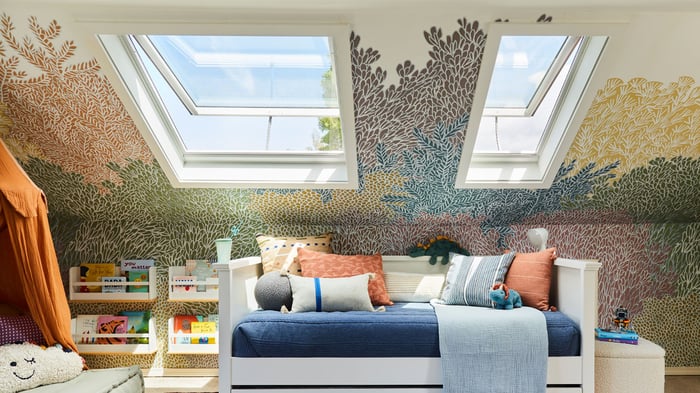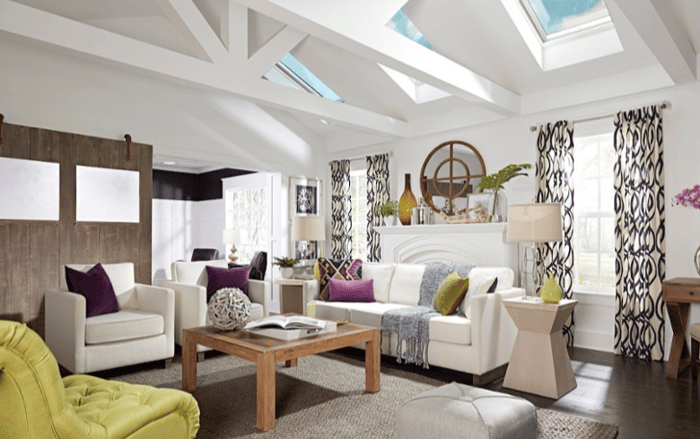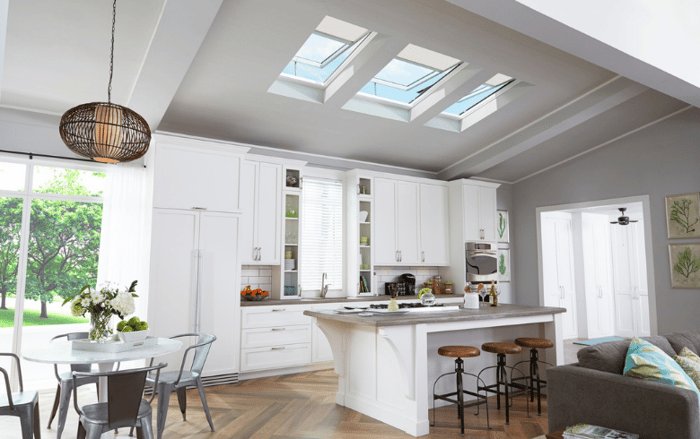What You Need to Know About Skylights and Energy Efficiency
Read Time 4 mins | Written by: VELUX Skylights

One of the most common misconceptions about skylights is how they contribute to the energy efficiency of a home. While skylights of the past may not have been considered the most energy-efficient, new technologies are paving the way for greener skylights.
So, first things first, let's answer the big question:
Are Skylights Energy-Efficient?
If you do your skylight research and work with a Grade A installer: yes, skylights can be an energy-efficient asset to your home. The right skylight installed in the right area can help light and heat your home during colder months and keep it cool during the warmer months. Relying more on your skylights for natural light and ventilation can help you rely less on central heating and air systems, leading to an overall greener household.
What to Consider for Optimal Energy Efficiency
Now, you may have noticed we said "the right skylight in the right area" is what creates better energy efficiency. That's because improper installation or skylight selection can sometimes have the opposite effect. Here's what to consider before you install skylights to ensure optimal energy efficiency:
Skylight Type
Not all skylights are the same. So, if energy efficiency is a major concern, opt for energy-efficient skylights. It seems simple to say, but how can you be sure you're choosing the most energy-efficient skylight option for your home? To determine this, you'll need to know the skylight's ENERGY STAR status, U-factor, and solar heat gain coefficient (SHGC).
ENERGY STAR® Performance
For the most energy-efficient skylight selection based on your local climate and home design, the US Department of Energy recommends understanding the energy performance ratings of skylights. You can also look for an ENERGY STAR® label when choosing a skylight. ENERGY STAR has established minimum energy performance rating criteria by climate, which is based on more detailed ratings from the National Fenestration Rating Council (NFRC). So, if you see an ENERGY STAR or NFRC label on your skylight, you're guaranteed an energy-efficient model.
U-Factor & SHGC
Another thing to consider is a skylight's U-factor. The U-factor measures how much non-solar heat energy is transferred. So, a lower U-factor means a more energy-efficient skylight. You can find a skylight's U-factor in its energy efficiency rating.
You'll also want to look at the solar heat gain coefficient (SHGC), which tells you how much solar energy is transmitted and converted to heat through the skylight. A higher SHGC means more heat is transferred through the skylight, which can be helpful during the winter. Conversely, a lower SHGC provides better shading ability, meaning less heat transfer.
Skylight Size
The physical size of a skylight greatly affects the light levels and temperature of the space below. A good rule of thumb to follow with skylight size is that it should be no more than 5% of the floor area in rooms with a lot of windows and no more than 15% of the room's total floor area for spaces with few windows.
Skylight Location
For optimal energy efficiency, the location of the skylight on your roof can maximize daylighting and/or passive solar heating potential. Skylights on roofs that face north provide fairly constant but cool sunlight. Those on east-facing roofs provide maximum light and solar heat gain in the morning, while west-facing skylights provide afternoon sun and heat gain. South-facing skylights provide the greatest potential for passive solar heat gain in the winter, but often allow unwanted heat gain in the summer.
Skylight Slope
The slope of the skylight as it sits on your roof also affects solar heat gain. Lower slopes, for example, admit more solar heat in the summer and less in the winter — something you usually don't want. To figure out the optimal skylight slope for your climate, add 5-15° to your geographical latitude. Columbus, OH, for example, is at 40° north latitude, so the optimum slope for a south-facing skylight there is 45-55°.
Skylight Ventilation
Skylights that open and close offer natural venting capabilities that can improve indoor air quality while giving your air conditioning or HVAC system a break. Venting skylights can especially help the energy efficiency of kitchens and bathrooms. New skylight automation technologies, like rain sensors and VELUX ACTIVE with NETATMO, can also help improve the energy efficiency of venting skylights.
Skylight Installation
Even the most energy-efficient skylight needs to be properly installed to ensure it achieves its best energy performance. So, while you can DIY a skylight installation, it's best to opt for a professional installer. Before the skylights are installed, they can help you make the best, most energy-efficient decision for your home. And during and after installation, they will ensure a water-tight seal and that your skylights are in perfect working order.
When it comes to choosing energy-efficient skylights, VELUX Skylights are the best option. Our skylights are ENERGY STAR certified and are protected by our 10-year Installation Warranty. Check out our Installer Locator to find a trusted skylight installer near you! Or if you have more questions about VELUX Skylights and energy efficiency, schedule a free virtual consultation with one of our design experts.
VELUX Skylight Systems
Reimagine Your Home With Natural Light and Fresh Air

EDUCATION
Maximizing Energy Efficiency with Skylights
Discover how skylights can help homeowners maximize energy efficiency in their homes.
Keep Reading
SKYLIGHT INNOVATIONS
Why Skylights Are Key To Living Green
Improve the eco-efficiency of your home with skylights.
Keep Reading
PRODUCT TIPS
The Good, Better, & Best of Skylights
Did you know you have options when it comes to skylights? These are the good, better, and best ways ...
Keep Reading